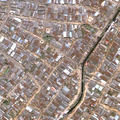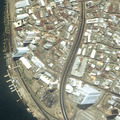
Lagos - Exercises using IKONOS data


 |  |
IKONOS 2 in space
| |
The IKONOS 2 satellite was launched in September 1999. From early 2000 it has been delivering commercial high resolution data. IKONOS records 4 channels of multispectral data with 4 metres resolution and a panchromatic channel with 1 metre resolution. IKONOS was the first commercial satellite to provide high resolution images of photographic quality from all over the world.
The radiometric resolution of IKONOS is 11 bit per pixel (2048 grey tones). That means that the images show much more information than the usual 8 bit (256 grey tones) data. In order to benefit from this additional information, a special image processing software is required.
IKONOS has both cross- and along-track viewing instruments which enable flexible data acquisitions and frequent revisiting capabilities - 3 days at 1 metre resolution and 1 to 2 days at 1.5 metres resolution.
 |  | | |
Lagos as seen by IKONOS 1
|
IKONOS images certainly provide one of the most impressive views of the Earth's surface. With a ground resolution down to 1 metre, an IKONOS image is very similar to an aerial photograph. It is possible to detect the individual structures of streets, houses and city quarters. The satellite data are used for disaster monitoring and mapping in general. The IKONOS images on this page show two quite spectacularly different faces of Lagos.
Download both images in a zipped TIF format (1.3 MB).
Describe both images. What features are identifiable?
Compare both images with respect to the city structure and describe the differences. What are the reasons for the different structures?
Which of the two images shows the financial and commercial district?
What does the other image represent?
The images cover an area of 512 x 512 m², as a result of a ground resolution of 1 m and an image resolution of 512 pixel. This is only a very small part of a huge city.
The next part of the exercise is to allocate the images to the 30 m ground resolution image Lagos_Landsat_Band_321.tif
| Ikonos bands | | | Band Width | | Spatial Resolution | | Panchromatic | 0.45 - 0.90 µm | | 1 metre | | Band 1 | 0.45 - 0.53 µm | BLUE | 4 metres | | Band 2 | 0.52 - 0.61 µm | GREEN | 4 metres | | Band 3 | 0.64 - 0.72 µm | RED | 4 metres |
|
 |  |
Lagos as seen by IKONOS 2
| |
Repeat the same steps using the image lagos_ikonos2.tif and allocate the image to the Landsat scene.
Select (activate) image lagos_ikonos2.tif and observe the direction of the shadows.
Try to answer the following questions:
Why is the direction of the shadows south-west, although the city is located within the northern hemisphere?
Is that phenomenon possible in your hometown, too?
In which part of the year and at approximately what time was the image taken?
Last update: 16 April 2013

 |  | 
Lagos

| | • | Introduction (http://www.esa.int/SPECIALS/Eduspace_Global_EN/SEMVJSTTGOF_0.html) |  | | • | Background (http://www.esa.int/SPECIALS/Eduspace_Global_EN/SEMBISTTGOF_0.html) |  | 
Exercises

| | • | Worksheet introduction (http://www.esa.int/SPECIALS/Eduspace_Global_EN/SEM3F7UTGOF_0.html) |  | | • | Exercises using Landsat data (http://www.esa.int/SPECIALS/Eduspace_Global_EN/SEM3G7UTGOF_0.html) |  | 
Eduspace - Software

| | • | LEOWorks 3 (http://esamultimedia.esa.int/multimedia/LEOWorks3.exe) |  | 
Eduspace - Download

| | • | lagos.zip (http://esamultimedia.esa.int/multimedia/eduspace/lagos.zip) |  | | • | Technical information about Landsat bands (PDF) (http://esamultimedia.esa.int/docs/eduspace/Technical_data_LANDSAT_bands.pdf) |  |

| 
